2005 CHRYSLER CARAVAN warning light
[x] Cancel search: warning lightPage 2173 of 2339

BLEND DOOR ACTUATOR
DESCRIPTION
The blend door actuators are reversible, 12-volt
Direct Current (DC), servo motors. Models with the
single zone heater and air conditioner system have a
single blend air door, which is controlled by a single
blend door actuator. Models with the optional dual
zone front heater and air conditioner system have
dual blend air doors, which are controlled by two
blend door actuators. The single zone blend door
actuator is located on the driver's side end of the
HVAC housing, close to the middle of the distribution
housing. In the dual zone system, the same blend
door actuator used for the single zone system
becomes the passenger blend door actuator, and is
mechanically connected to only the passenger side
blend air door. In the dual zone system, a second sep-
arate blend door actuator is also located on the
driver side end of the HVAC housing, close to the
middle of the distribution housing, and is mechani-
cally connected to only the driver's side blend air
door.
The blend door actuators are interchangeable with
each other, as well as with the actuators for the
mode door and the recirculation air door. Each actua-
tor is contained within an identical black molded
plastic housing with an integral wire connector
receptacle. Two integral mounting tabs allow the
actuator to be secured with two screws to the distri-
bution housing. Each actuator also has an identical
output shaft with splines that connects it to the link-
age that drives the proper blend air door. The blend
door actuators do not require mechanical indexing to
the blend door linkage, as they are electronically cal-
ibrated by the heater-A/C control module.
OPERATION
The blend door actuators are connected to the A/C-
heater control through the vehicle electrical system
by a dedicated two-wire lead and connector of the
HVAC wire harness. The blend door actuator(s) can
move the blend-air door(s) in two directions. When
the A/C-heater control pulls the voltage on one side
of the motor connection high and the other connec-
tion low, the blend-air door will move in one direc-
tion. When the A/C-heater control reverses the
polarity of the voltage to the motor, the blend-air
door moves in the opposite direction.
When the A/C-heater control makes the voltage to
both connections high or both connections low, the
blend-air door stops and will not move. The A/C-
heater control uses a feedback signal positioning sys-
tem to monitor the operation and relative position of
the blend door actuator(s) and the blend-air door(s).
The A/C-heater control learns the blend-air door stoppositions during the calibration procedure and will
store a diagnostic trouble code (DTC) for any prob-
lems it detects in the blend door actuator circuits.
The blend door actuators are diagnosed using a
scan tool (Refer to 24 - HEATING & AIR CONDI-
TIONING - DIAGNOSIS AND TESTING and to 24 -
HVAC Electrical Diagnostics for more information).
The blend door actuators cannot be adjusted or
repaired and, if faulty or damaged, they must be
replaced.
REMOVAL
WARNING: ON VEHICLES EQUIPPED WITH AIR-
BAGS, DISABLE THE AIRBAG SYSTEM BEFORE
ATTEMPTING ANY STEERING WHEEL, STEERING
COLUMN, OR INSTRUMENT PANEL COMPONENT
DIAGNOSIS OR SERVICE. DISCONNECT AND ISO-
LATE THE BATTERY NEGATIVE (GROUND) CABLE,
THEN WAIT TWO MINUTES FOR THE AIRBAG SYS-
TEM CAPACITOR TO DISCHARGE BEFORE PER-
FORMING FURTHER DIAGNOSIS OR SERVICE. THIS
IS THE ONLY SURE WAY TO DISABLE THE AIRBAG
SYSTEM. FAILURE TO TAKE THE PROPER PRE-
CAUTIONS COULD RESULT IN ACCIDENTAL AIR-
BAG DEPLOYMENT AND POSSIBLE PERSONAL
INJURY.
NOTE: The single zone heating and air conditioning
system is equipped with a single blend door actua-
tor. The dual zone system has two blend door
actuators, one for the driver side blend air door and
one for the passenger side blend air door. The
same service procedures can be used for each of
these actuators.
(1) Disconnect and isolate the battery negative
cable.
(2) Remove the silencer from beneath the driver
side end of the instrument panel. (Refer to 23 -
BODY/INSTRUMENT PANEL/INSTRUMENT
PANEL SILENCER - REMOVAL).
(3) Disconnect the wire harness connector from the
blend door actuator(s) (Fig. 11).
(4) Remove the two screws that secure the blend
door actuator to the distribution housing.
(5) Remove the blend door actuator.
INSTALLATION
(1) Position the blend door actuator onto the distri-
bution housing. If necessary, rotate the actuator
slightly to align the splines on the actuator output
shaft with those in the blend air door linkage.
(2) Install the two screws that secure the blend
door actuator to the housing. Tighten the screws to 2
N´m (17 in. lbs.).
24 - 22 CONTROLS - FRONTRS
Page 2181 of 2339
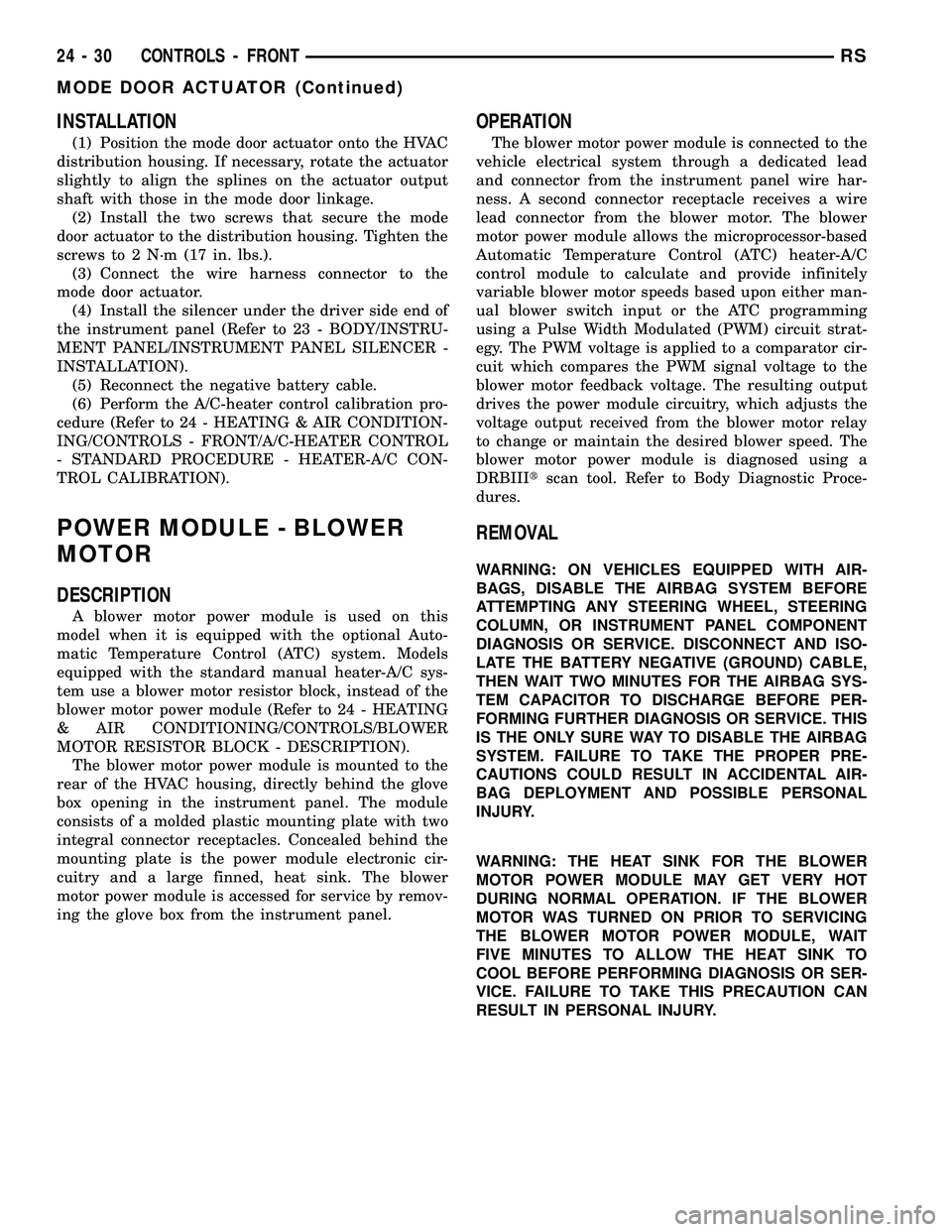
INSTALLATION
(1) Position the mode door actuator onto the HVAC
distribution housing. If necessary, rotate the actuator
slightly to align the splines on the actuator output
shaft with those in the mode door linkage.
(2) Install the two screws that secure the mode
door actuator to the distribution housing. Tighten the
screws to 2 N´m (17 in. lbs.).
(3) Connect the wire harness connector to the
mode door actuator.
(4) Install the silencer under the driver side end of
the instrument panel (Refer to 23 - BODY/INSTRU-
MENT PANEL/INSTRUMENT PANEL SILENCER -
INSTALLATION).
(5) Reconnect the negative battery cable.
(6) Perform the A/C-heater control calibration pro-
cedure (Refer to 24 - HEATING & AIR CONDITION-
ING/CONTROLS - FRONT/A/C-HEATER CONTROL
- STANDARD PROCEDURE - HEATER-A/C CON-
TROL CALIBRATION).
POWER MODULE - BLOWER
MOTOR
DESCRIPTION
A blower motor power module is used on this
model when it is equipped with the optional Auto-
matic Temperature Control (ATC) system. Models
equipped with the standard manual heater-A/C sys-
tem use a blower motor resistor block, instead of the
blower motor power module (Refer to 24 - HEATING
& AIR CONDITIONING/CONTROLS/BLOWER
MOTOR RESISTOR BLOCK - DESCRIPTION).
The blower motor power module is mounted to the
rear of the HVAC housing, directly behind the glove
box opening in the instrument panel. The module
consists of a molded plastic mounting plate with two
integral connector receptacles. Concealed behind the
mounting plate is the power module electronic cir-
cuitry and a large finned, heat sink. The blower
motor power module is accessed for service by remov-
ing the glove box from the instrument panel.
OPERATION
The blower motor power module is connected to the
vehicle electrical system through a dedicated lead
and connector from the instrument panel wire har-
ness. A second connector receptacle receives a wire
lead connector from the blower motor. The blower
motor power module allows the microprocessor-based
Automatic Temperature Control (ATC) heater-A/C
control module to calculate and provide infinitely
variable blower motor speeds based upon either man-
ual blower switch input or the ATC programming
using a Pulse Width Modulated (PWM) circuit strat-
egy. The PWM voltage is applied to a comparator cir-
cuit which compares the PWM signal voltage to the
blower motor feedback voltage. The resulting output
drives the power module circuitry, which adjusts the
voltage output received from the blower motor relay
to change or maintain the desired blower speed. The
blower motor power module is diagnosed using a
DRBIIItscan tool. Refer to Body Diagnostic Proce-
dures.
REMOVAL
WARNING: ON VEHICLES EQUIPPED WITH AIR-
BAGS, DISABLE THE AIRBAG SYSTEM BEFORE
ATTEMPTING ANY STEERING WHEEL, STEERING
COLUMN, OR INSTRUMENT PANEL COMPONENT
DIAGNOSIS OR SERVICE. DISCONNECT AND ISO-
LATE THE BATTERY NEGATIVE (GROUND) CABLE,
THEN WAIT TWO MINUTES FOR THE AIRBAG SYS-
TEM CAPACITOR TO DISCHARGE BEFORE PER-
FORMING FURTHER DIAGNOSIS OR SERVICE. THIS
IS THE ONLY SURE WAY TO DISABLE THE AIRBAG
SYSTEM. FAILURE TO TAKE THE PROPER PRE-
CAUTIONS COULD RESULT IN ACCIDENTAL AIR-
BAG DEPLOYMENT AND POSSIBLE PERSONAL
INJURY.
WARNING: THE HEAT SINK FOR THE BLOWER
MOTOR POWER MODULE MAY GET VERY HOT
DURING NORMAL OPERATION. IF THE BLOWER
MOTOR WAS TURNED ON PRIOR TO SERVICING
THE BLOWER MOTOR POWER MODULE, WAIT
FIVE MINUTES TO ALLOW THE HEAT SINK TO
COOL BEFORE PERFORMING DIAGNOSIS OR SER-
VICE. FAILURE TO TAKE THIS PRECAUTION CAN
RESULT IN PERSONAL INJURY.
24 - 30 CONTROLS - FRONTRS
MODE DOOR ACTUATOR (Continued)
Page 2183 of 2339
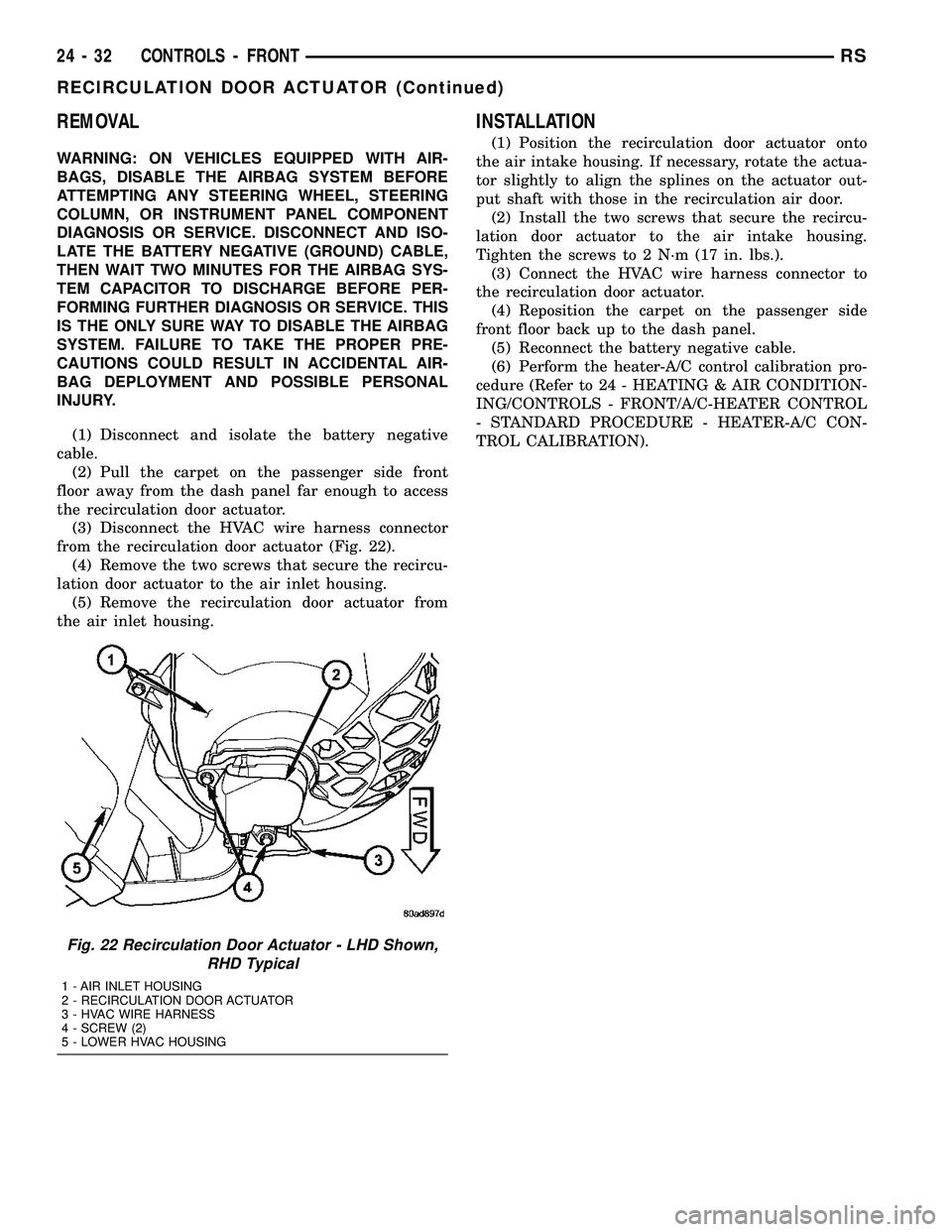
REMOVAL
WARNING: ON VEHICLES EQUIPPED WITH AIR-
BAGS, DISABLE THE AIRBAG SYSTEM BEFORE
ATTEMPTING ANY STEERING WHEEL, STEERING
COLUMN, OR INSTRUMENT PANEL COMPONENT
DIAGNOSIS OR SERVICE. DISCONNECT AND ISO-
LATE THE BATTERY NEGATIVE (GROUND) CABLE,
THEN WAIT TWO MINUTES FOR THE AIRBAG SYS-
TEM CAPACITOR TO DISCHARGE BEFORE PER-
FORMING FURTHER DIAGNOSIS OR SERVICE. THIS
IS THE ONLY SURE WAY TO DISABLE THE AIRBAG
SYSTEM. FAILURE TO TAKE THE PROPER PRE-
CAUTIONS COULD RESULT IN ACCIDENTAL AIR-
BAG DEPLOYMENT AND POSSIBLE PERSONAL
INJURY.
(1) Disconnect and isolate the battery negative
cable.
(2) Pull the carpet on the passenger side front
floor away from the dash panel far enough to access
the recirculation door actuator.
(3) Disconnect the HVAC wire harness connector
from the recirculation door actuator (Fig. 22).
(4) Remove the two screws that secure the recircu-
lation door actuator to the air inlet housing.
(5) Remove the recirculation door actuator from
the air inlet housing.
INSTALLATION
(1) Position the recirculation door actuator onto
the air intake housing. If necessary, rotate the actua-
tor slightly to align the splines on the actuator out-
put shaft with those in the recirculation air door.
(2) Install the two screws that secure the recircu-
lation door actuator to the air intake housing.
Tighten the screws to 2 N´m (17 in. lbs.).
(3) Connect the HVAC wire harness connector to
the recirculation door actuator.
(4) Reposition the carpet on the passenger side
front floor back up to the dash panel.
(5) Reconnect the battery negative cable.
(6) Perform the heater-A/C control calibration pro-
cedure (Refer to 24 - HEATING & AIR CONDITION-
ING/CONTROLS - FRONT/A/C-HEATER CONTROL
- STANDARD PROCEDURE - HEATER-A/C CON-
TROL CALIBRATION).
Fig. 22 Recirculation Door Actuator - LHD Shown,
RHD Typical
1 - AIR INLET HOUSING
2 - RECIRCULATION DOOR ACTUATOR
3 - HVAC WIRE HARNESS
4 - SCREW (2)
5 - LOWER HVAC HOUSING
24 - 32 CONTROLS - FRONTRS
RECIRCULATION DOOR ACTUATOR (Continued)
Page 2216 of 2339
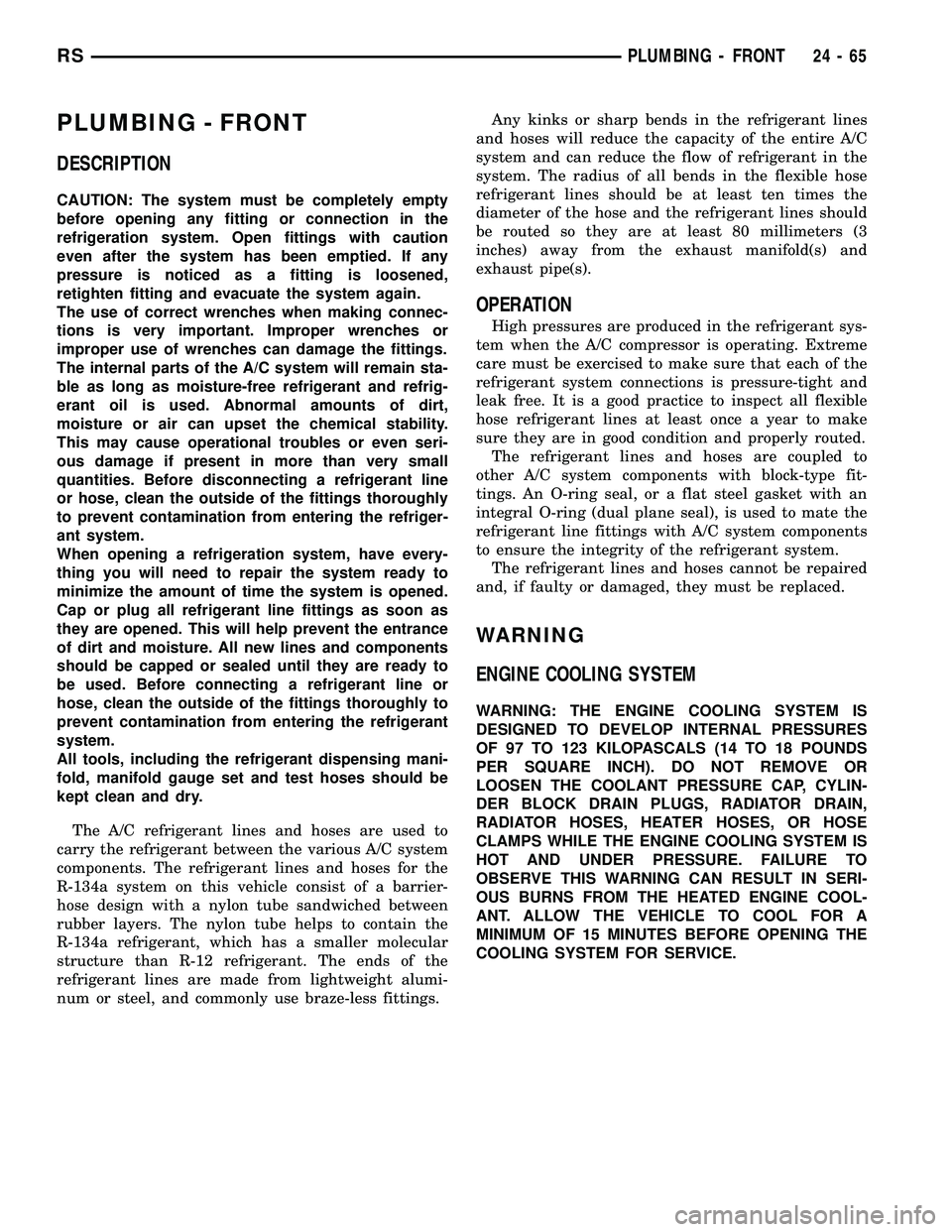
PLUMBING - FRONT
DESCRIPTION
CAUTION: The system must be completely empty
before opening any fitting or connection in the
refrigeration system. Open fittings with caution
even after the system has been emptied. If any
pressure is noticed as a fitting is loosened,
retighten fitting and evacuate the system again.
The use of correct wrenches when making connec-
tions is very important. Improper wrenches or
improper use of wrenches can damage the fittings.
The internal parts of the A/C system will remain sta-
ble as long as moisture-free refrigerant and refrig-
erant oil is used. Abnormal amounts of dirt,
moisture or air can upset the chemical stability.
This may cause operational troubles or even seri-
ous damage if present in more than very small
quantities. Before disconnecting a refrigerant line
or hose, clean the outside of the fittings thoroughly
to prevent contamination from entering the refriger-
ant system.
When opening a refrigeration system, have every-
thing you will need to repair the system ready to
minimize the amount of time the system is opened.
Cap or plug all refrigerant line fittings as soon as
they are opened. This will help prevent the entrance
of dirt and moisture. All new lines and components
should be capped or sealed until they are ready to
be used. Before connecting a refrigerant line or
hose, clean the outside of the fittings thoroughly to
prevent contamination from entering the refrigerant
system.
All tools, including the refrigerant dispensing mani-
fold, manifold gauge set and test hoses should be
kept clean and dry.
The A/C refrigerant lines and hoses are used to
carry the refrigerant between the various A/C system
components. The refrigerant lines and hoses for the
R-134a system on this vehicle consist of a barrier-
hose design with a nylon tube sandwiched between
rubber layers. The nylon tube helps to contain the
R-134a refrigerant, which has a smaller molecular
structure than R-12 refrigerant. The ends of the
refrigerant lines are made from lightweight alumi-
num or steel, and commonly use braze-less fittings.Any kinks or sharp bends in the refrigerant lines
and hoses will reduce the capacity of the entire A/C
system and can reduce the flow of refrigerant in the
system. The radius of all bends in the flexible hose
refrigerant lines should be at least ten times the
diameter of the hose and the refrigerant lines should
be routed so they are at least 80 millimeters (3
inches) away from the exhaust manifold(s) and
exhaust pipe(s).
OPERATION
High pressures are produced in the refrigerant sys-
tem when the A/C compressor is operating. Extreme
care must be exercised to make sure that each of the
refrigerant system connections is pressure-tight and
leak free. It is a good practice to inspect all flexible
hose refrigerant lines at least once a year to make
sure they are in good condition and properly routed.
The refrigerant lines and hoses are coupled to
other A/C system components with block-type fit-
tings. An O-ring seal, or a flat steel gasket with an
integral O-ring (dual plane seal), is used to mate the
refrigerant line fittings with A/C system components
to ensure the integrity of the refrigerant system.
The refrigerant lines and hoses cannot be repaired
and, if faulty or damaged, they must be replaced.
WARNING
ENGINE COOLING SYSTEM
WARNING: THE ENGINE COOLING SYSTEM IS
DESIGNED TO DEVELOP INTERNAL PRESSURES
OF 97 TO 123 KILOPASCALS (14 TO 18 POUNDS
PER SQUARE INCH). DO NOT REMOVE OR
LOOSEN THE COOLANT PRESSURE CAP, CYLIN-
DER BLOCK DRAIN PLUGS, RADIATOR DRAIN,
RADIATOR HOSES, HEATER HOSES, OR HOSE
CLAMPS WHILE THE ENGINE COOLING SYSTEM IS
HOT AND UNDER PRESSURE. FAILURE TO
OBSERVE THIS WARNING CAN RESULT IN SERI-
OUS BURNS FROM THE HEATED ENGINE COOL-
ANT. ALLOW THE VEHICLE TO COOL FOR A
MINIMUM OF 15 MINUTES BEFORE OPENING THE
COOLING SYSTEM FOR SERVICE.
RSPLUMBING - FRONT24-65
Page 2235 of 2339
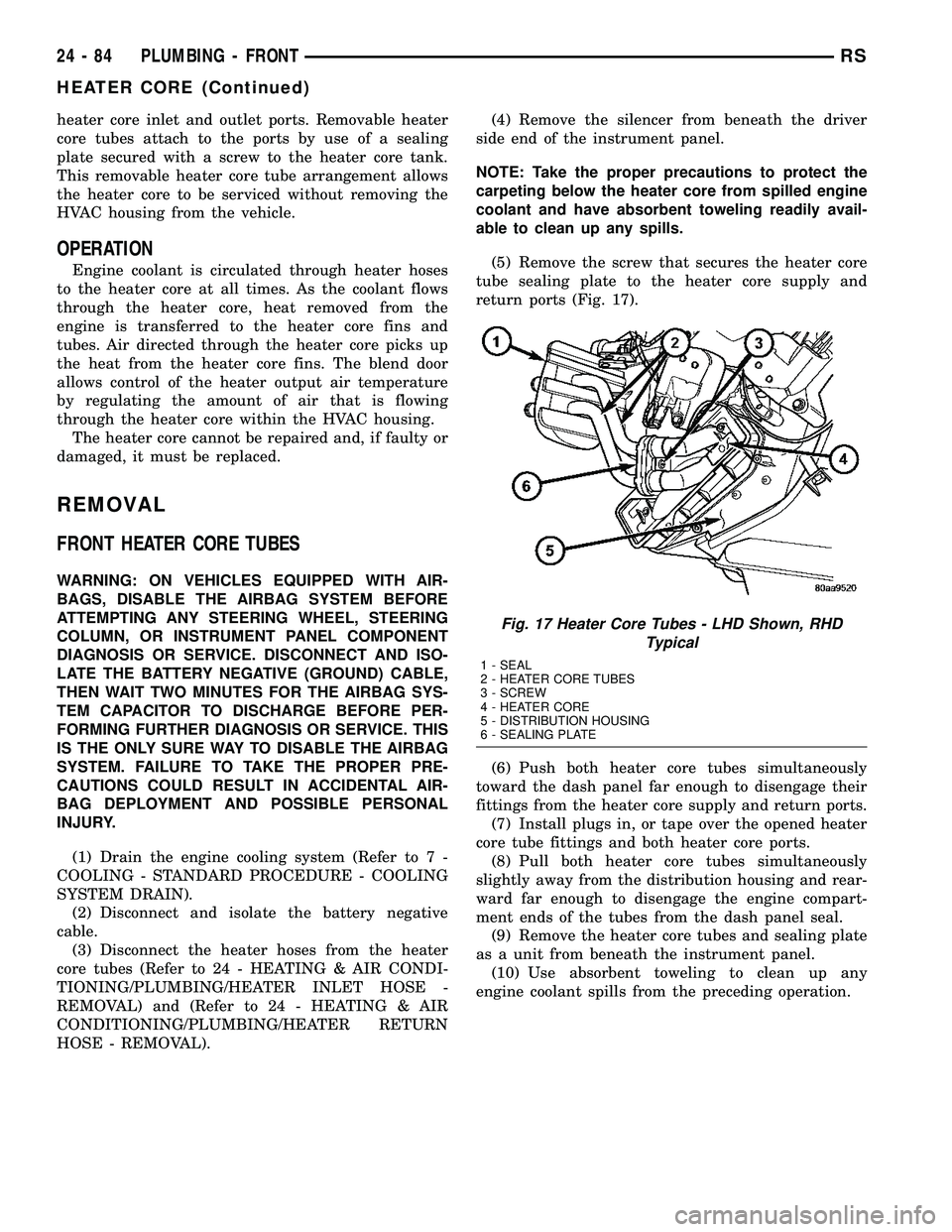
heater core inlet and outlet ports. Removable heater
core tubes attach to the ports by use of a sealing
plate secured with a screw to the heater core tank.
This removable heater core tube arrangement allows
the heater core to be serviced without removing the
HVAC housing from the vehicle.
OPERATION
Engine coolant is circulated through heater hoses
to the heater core at all times. As the coolant flows
through the heater core, heat removed from the
engine is transferred to the heater core fins and
tubes. Air directed through the heater core picks up
the heat from the heater core fins. The blend door
allows control of the heater output air temperature
by regulating the amount of air that is flowing
through the heater core within the HVAC housing.
The heater core cannot be repaired and, if faulty or
damaged, it must be replaced.
REMOVAL
FRONT HEATER CORE TUBES
WARNING: ON VEHICLES EQUIPPED WITH AIR-
BAGS, DISABLE THE AIRBAG SYSTEM BEFORE
ATTEMPTING ANY STEERING WHEEL, STEERING
COLUMN, OR INSTRUMENT PANEL COMPONENT
DIAGNOSIS OR SERVICE. DISCONNECT AND ISO-
LATE THE BATTERY NEGATIVE (GROUND) CABLE,
THEN WAIT TWO MINUTES FOR THE AIRBAG SYS-
TEM CAPACITOR TO DISCHARGE BEFORE PER-
FORMING FURTHER DIAGNOSIS OR SERVICE. THIS
IS THE ONLY SURE WAY TO DISABLE THE AIRBAG
SYSTEM. FAILURE TO TAKE THE PROPER PRE-
CAUTIONS COULD RESULT IN ACCIDENTAL AIR-
BAG DEPLOYMENT AND POSSIBLE PERSONAL
INJURY.
(1) Drain the engine cooling system (Refer to 7 -
COOLING - STANDARD PROCEDURE - COOLING
SYSTEM DRAIN).
(2) Disconnect and isolate the battery negative
cable.
(3) Disconnect the heater hoses from the heater
core tubes (Refer to 24 - HEATING & AIR CONDI-
TIONING/PLUMBING/HEATER INLET HOSE -
REMOVAL) and (Refer to 24 - HEATING & AIR
CONDITIONING/PLUMBING/HEATER RETURN
HOSE - REMOVAL).(4) Remove the silencer from beneath the driver
side end of the instrument panel.
NOTE: Take the proper precautions to protect the
carpeting below the heater core from spilled engine
coolant and have absorbent toweling readily avail-
able to clean up any spills.
(5) Remove the screw that secures the heater core
tube sealing plate to the heater core supply and
return ports (Fig. 17).
(6) Push both heater core tubes simultaneously
toward the dash panel far enough to disengage their
fittings from the heater core supply and return ports.
(7) Install plugs in, or tape over the opened heater
core tube fittings and both heater core ports.
(8) Pull both heater core tubes simultaneously
slightly away from the distribution housing and rear-
ward far enough to disengage the engine compart-
ment ends of the tubes from the dash panel seal.
(9) Remove the heater core tubes and sealing plate
as a unit from beneath the instrument panel.
(10) Use absorbent toweling to clean up any
engine coolant spills from the preceding operation.
Fig. 17 Heater Core Tubes - LHD Shown, RHD
Typical
1 - SEAL
2 - HEATER CORE TUBES
3 - SCREW
4 - HEATER CORE
5 - DISTRIBUTION HOUSING
6 - SEALING PLATE
24 - 84 PLUMBING - FRONTRS
HEATER CORE (Continued)
Page 2236 of 2339
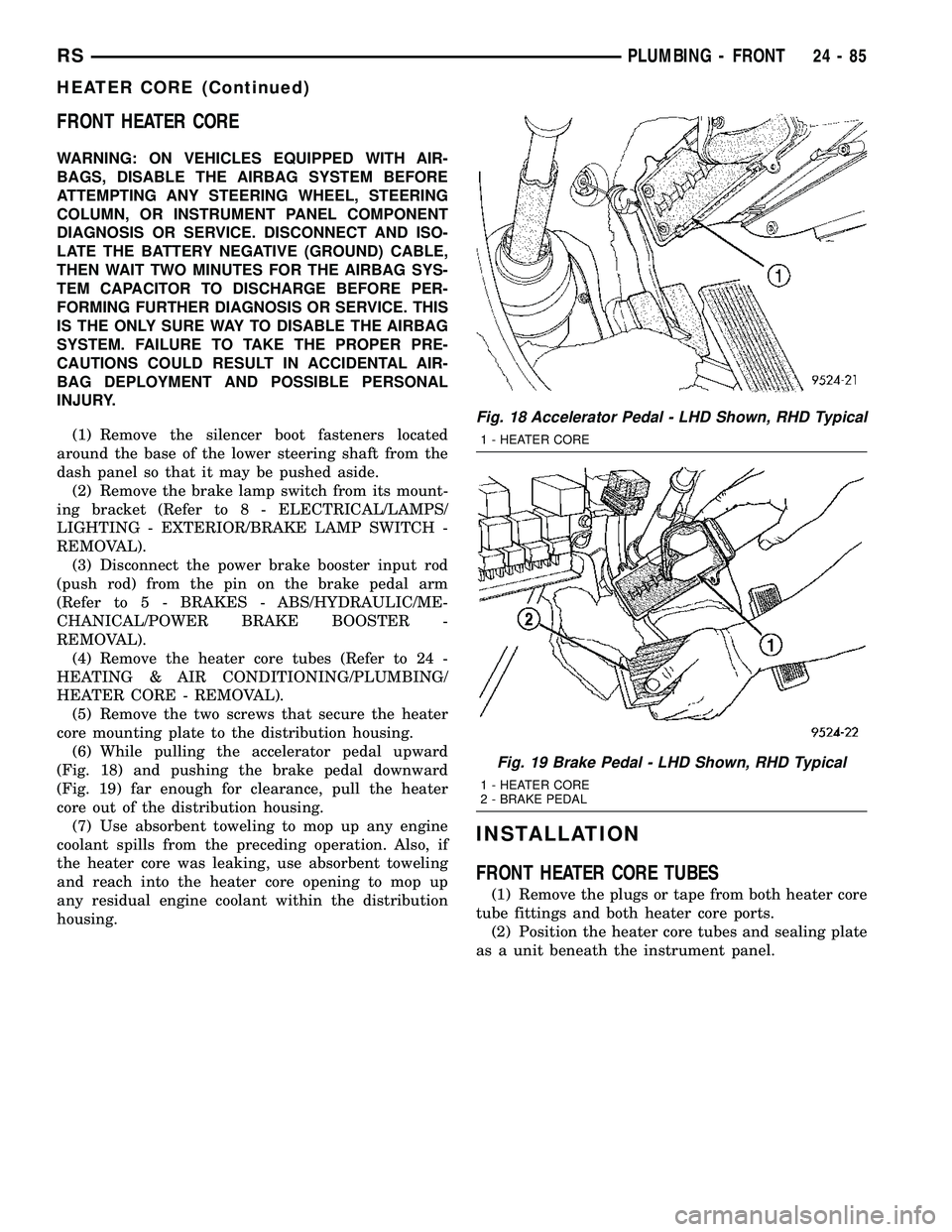
FRONT HEATER CORE
WARNING: ON VEHICLES EQUIPPED WITH AIR-
BAGS, DISABLE THE AIRBAG SYSTEM BEFORE
ATTEMPTING ANY STEERING WHEEL, STEERING
COLUMN, OR INSTRUMENT PANEL COMPONENT
DIAGNOSIS OR SERVICE. DISCONNECT AND ISO-
LATE THE BATTERY NEGATIVE (GROUND) CABLE,
THEN WAIT TWO MINUTES FOR THE AIRBAG SYS-
TEM CAPACITOR TO DISCHARGE BEFORE PER-
FORMING FURTHER DIAGNOSIS OR SERVICE. THIS
IS THE ONLY SURE WAY TO DISABLE THE AIRBAG
SYSTEM. FAILURE TO TAKE THE PROPER PRE-
CAUTIONS COULD RESULT IN ACCIDENTAL AIR-
BAG DEPLOYMENT AND POSSIBLE PERSONAL
INJURY.
(1) Remove the silencer boot fasteners located
around the base of the lower steering shaft from the
dash panel so that it may be pushed aside.
(2) Remove the brake lamp switch from its mount-
ing bracket (Refer to 8 - ELECTRICAL/LAMPS/
LIGHTING - EXTERIOR/BRAKE LAMP SWITCH -
REMOVAL).
(3) Disconnect the power brake booster input rod
(push rod) from the pin on the brake pedal arm
(Refer to 5 - BRAKES - ABS/HYDRAULIC/ME-
CHANICAL/POWER BRAKE BOOSTER -
REMOVAL).
(4) Remove the heater core tubes (Refer to 24 -
HEATING & AIR CONDITIONING/PLUMBING/
HEATER CORE - REMOVAL).
(5) Remove the two screws that secure the heater
core mounting plate to the distribution housing.
(6) While pulling the accelerator pedal upward
(Fig. 18) and pushing the brake pedal downward
(Fig. 19) far enough for clearance, pull the heater
core out of the distribution housing.
(7) Use absorbent toweling to mop up any engine
coolant spills from the preceding operation. Also, if
the heater core was leaking, use absorbent toweling
and reach into the heater core opening to mop up
any residual engine coolant within the distribution
housing.
INSTALLATION
FRONT HEATER CORE TUBES
(1) Remove the plugs or tape from both heater core
tube fittings and both heater core ports.
(2) Position the heater core tubes and sealing plate
as a unit beneath the instrument panel.
Fig. 18 Accelerator Pedal - LHD Shown, RHD Typical
1 - HEATER CORE
Fig. 19 Brake Pedal - LHD Shown, RHD Typical
1 - HEATER CORE
2 - BRAKE PEDAL
RSPLUMBING - FRONT24-85
HEATER CORE (Continued)
Page 2237 of 2339
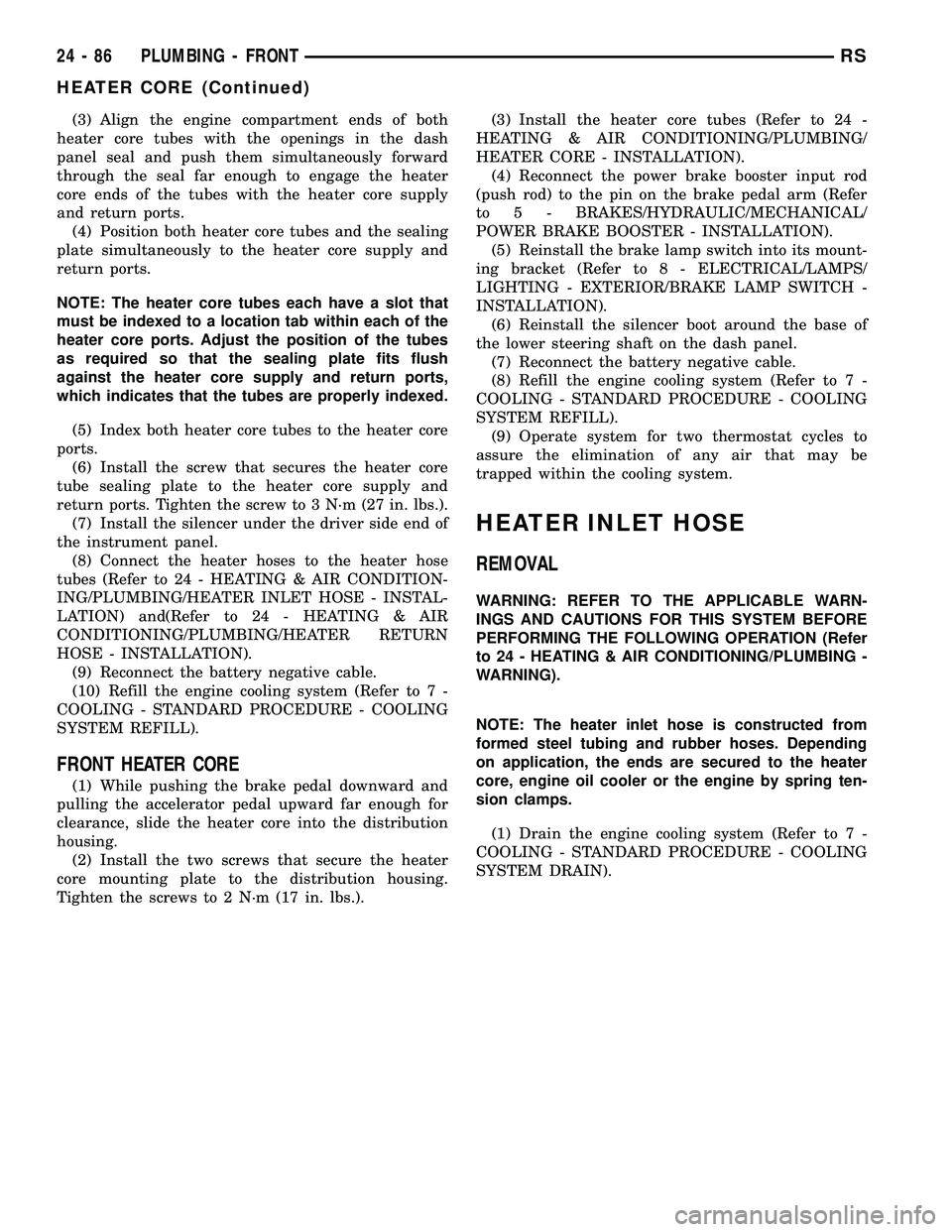
(3) Align the engine compartment ends of both
heater core tubes with the openings in the dash
panel seal and push them simultaneously forward
through the seal far enough to engage the heater
core ends of the tubes with the heater core supply
and return ports.
(4) Position both heater core tubes and the sealing
plate simultaneously to the heater core supply and
return ports.
NOTE: The heater core tubes each have a slot that
must be indexed to a location tab within each of the
heater core ports. Adjust the position of the tubes
as required so that the sealing plate fits flush
against the heater core supply and return ports,
which indicates that the tubes are properly indexed.
(5) Index both heater core tubes to the heater core
ports.
(6) Install the screw that secures the heater core
tube sealing plate to the heater core supply and
return ports. Tighten the screw to 3 N´m (27 in. lbs.).
(7) Install the silencer under the driver side end of
the instrument panel.
(8) Connect the heater hoses to the heater hose
tubes (Refer to 24 - HEATING & AIR CONDITION-
ING/PLUMBING/HEATER INLET HOSE - INSTAL-
LATION) and(Refer to 24 - HEATING & AIR
CONDITIONING/PLUMBING/HEATER RETURN
HOSE - INSTALLATION).
(9) Reconnect the battery negative cable.
(10) Refill the engine cooling system (Refer to 7 -
COOLING - STANDARD PROCEDURE - COOLING
SYSTEM REFILL).
FRONT HEATER CORE
(1) While pushing the brake pedal downward and
pulling the accelerator pedal upward far enough for
clearance, slide the heater core into the distribution
housing.
(2) Install the two screws that secure the heater
core mounting plate to the distribution housing.
Tighten the screws to 2 N´m (17 in. lbs.).(3) Install the heater core tubes (Refer to 24 -
HEATING & AIR CONDITIONING/PLUMBING/
HEATER CORE - INSTALLATION).
(4) Reconnect the power brake booster input rod
(push rod) to the pin on the brake pedal arm (Refer
to 5 - BRAKES/HYDRAULIC/MECHANICAL/
POWER BRAKE BOOSTER - INSTALLATION).
(5) Reinstall the brake lamp switch into its mount-
ing bracket (Refer to 8 - ELECTRICAL/LAMPS/
LIGHTING - EXTERIOR/BRAKE LAMP SWITCH -
INSTALLATION).
(6) Reinstall the silencer boot around the base of
the lower steering shaft on the dash panel.
(7) Reconnect the battery negative cable.
(8) Refill the engine cooling system (Refer to 7 -
COOLING - STANDARD PROCEDURE - COOLING
SYSTEM REFILL).
(9) Operate system for two thermostat cycles to
assure the elimination of any air that may be
trapped within the cooling system.
HEATER INLET HOSE
REMOVAL
WARNING: REFER TO THE APPLICABLE WARN-
INGS AND CAUTIONS FOR THIS SYSTEM BEFORE
PERFORMING THE FOLLOWING OPERATION (Refer
to 24 - HEATING & AIR CONDITIONING/PLUMBING -
WARNING).
NOTE: The heater inlet hose is constructed from
formed steel tubing and rubber hoses. Depending
on application, the ends are secured to the heater
core, engine oil cooler or the engine by spring ten-
sion clamps.
(1) Drain the engine cooling system (Refer to 7 -
COOLING - STANDARD PROCEDURE - COOLING
SYSTEM DRAIN).
24 - 86 PLUMBING - FRONTRS
HEATER CORE (Continued)
Page 2312 of 2339
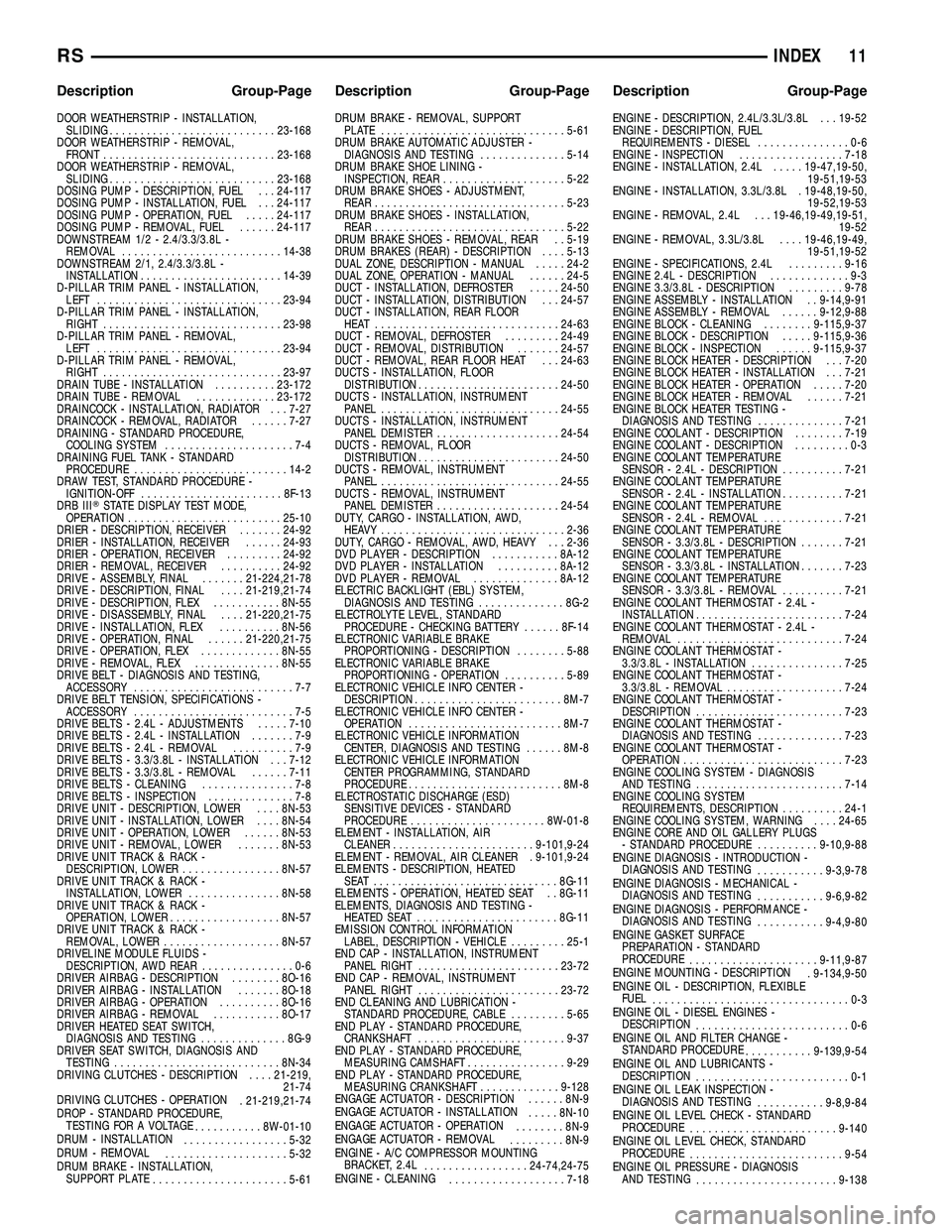
DOOR WEATHERSTRIP - INSTALLATION,SLIDING ........................... 23-168
DOOR WEATHERSTRIP - REMOVAL, FRONT ............................ 23-168
DOOR WEATHERSTRIP - REMOVAL, SLIDING ........................... 23-168
DOSING PUMP - DESCRIPTION, FUEL . . . 24-117
DOSING PUMP - INSTALLATION, FUEL . . . 24-117
DOSING PUMP - OPERATION, FUEL .....24-117
DOSING PUMP - REMOVAL, FUEL ......24-117
DOWNSTREAM 1/2 - 2.4/3.3/3.8L - REMOVAL .......................... 14-38
DOWNSTREAM 2/1, 2.4/3.3/3.8L - INSTALLATION ....................... 14-39
D-PILLAR TRIM PANEL - INSTALLATION, LEFT .............................. 23-94
D-PILLAR TRIM PANEL - INSTALLATION, RIGHT ............................. 23-98
D-PILLAR TRIM PANEL - REMOVAL, LEFT .............................. 23-94
D-PILLAR TRIM PANEL - REMOVAL, RIGHT ............................. 23-97
DRAIN TUBE - INSTALLATION ..........23-172
DRAIN TUBE - REMOVAL .............23-172
DRAINCOCK - INSTALLATION, RADIATOR . . . 7-27
DRAINCOCK - REMOVAL, RADIATOR ......7-27
DRAINING - STANDARD PROCEDURE, COOLING SYSTEM .....................7-4
DRAINING FUEL TANK - STANDARD PROCEDURE ......................... 14-2
DRAW TEST, STANDARD PROCEDURE - IGNITION-OFF ....................... 8F-13
DRB III TSTATE DISPLAY TEST MODE,
OPERATION ......................... 25-10
DRIER - DESCRIPTION, RECEIVER .......24-92
DRIER - INSTALLATION, RECEIVER ......24-93
DRIER - OPERATION, RECEIVER .........24-92
DRIER - REMOVAL, RECEIVER ..........24-92
DRIVE - ASSEMBLY, FINAL .......21-224,21-78
DRIVE - DESCRIPTION, FINAL ....21-219,21-74
DRIVE - DESCRIPTION, FLEX ...........8N-55
DRIVE - DISASSEMBLY, FINAL ....21-220,21-75
DRIVE - INSTALLATION, FLEX ..........8N-56
DRIVE - OPERATION, FINAL ......21-220,21-75
DRIVE - OPERATION, FLEX .............8N-55
DRIVE - REMOVAL, FLEX ..............8N-55
DRIVE BELT - DIAGNOSIS AND TESTING, ACCESSORY ..........................7-7
DRIVE BELT TENSION, SPECIFICATIONS - ACCESSORY ..........................7-5
DRIVE BELTS - 2.4L - ADJUSTMENTS .....7-10
DRIVE BELTS - 2.4L - INSTALLATION .......7-9
DRIVE BELTS - 2.4L - REMOVAL ..........7-9
DRIVE BELTS - 3.3/3.8L - INSTALLATION . . . 7-12
DRIVE BELTS - 3.3/3.8L - REMOVAL ......7-11
DRIVE BELTS - CLEANING ...............7-8
DRIVE BELTS - INSPECTION ..............7-8
DRIVE UNIT - DESCRIPTION, LOWER ....8N-53
DRIVE UNIT - INSTALLATION, LOWER ....8N-54
DRIVE UNIT - OPERATION, LOWER ......8N-53
DRIVE UNIT - REMOVAL, LOWER .......8N-53
DRIVE UNIT TRACK & RACK - DESCRIPTION, LOWER ................8N-57
DRIVE UNIT TRACK & RACK - INSTALLATION, LOWER ...............8N-58
DRIVE UNIT TRACK & RACK - OPERATION, LOWER .................. 8N-57
DRIVE UNIT TRACK & RACK - REMOVAL, LOWER ................... 8N-57
DRIVELINE MODULE FLUIDS - DESCRIPTION, AWD REAR ...............0-6
DRIVER AIRBAG - DESCRIPTION ........8O-16
DRIVER AIRBAG - INSTALLATION .......8O-18
DRIVER AIRBAG - OPERATION ..........8O-16
DRIVER AIRBAG - REMOVAL ...........8O-17
DRIVER HEATED SEAT SWITCH, DIAGNOSIS AND TESTING ..............8G-9
DRIVER SEAT SWITCH, DIAGNOSIS AND TESTING ........................... 8N-34
DRIVING CLUTCHES - DESCRIPTION ....21-219,
21-74
DRIVING CLUTCHES - OPERATION . 21-219,21-74
DROP - STANDARD PROCEDURE, TESTING FOR A VOLTAGE ...........8W-01-10
DRUM - INSTALLATION .................5-32
DRUM - REMOVAL .................... 5-32
DRUM BRAKE - INSTALLATION, SUPPORT PLATE ...................... 5-61DRUM BRAKE - REMOVAL, SUPPORT
PLATE .............................. 5-61
DRUM BRAKE AUTOMATIC ADJUSTER - DIAGNOSIS AND TESTING ..............5-14
DRUM BRAKE SHOE LINING - INSPECTION, REAR .................... 5-22
DRUM BRAKE SHOES - ADJUSTMENT, REAR ............................... 5-23
DRUM BRAKE SHOES - INSTALLATION, REAR ............................... 5-22
DRUM BRAKE SHOES - REMOVAL, REAR . . 5-19
DRUM BRAKES (REAR) - DESCRIPTION ....5-13
DUAL ZONE, DESCRIPTION - MANUAL .....24-2
DUAL ZONE, OPERATION - MANUAL ......24-5
DUCT - INSTALLATION, DEFROSTER .....24-50
DUCT - INSTALLATION, DISTRIBUTION . . . 24-57
DUCT - INSTALLATION, REAR FLOOR HEAT .............................. 24-63
DUCT - REMOVAL, DEFROSTER .........24-49
DUCT - REMOVAL, DISTRIBUTION .......24-57
DUCT - REMOVAL, REAR FLOOR HEAT . . . 24-63
DUCTS - INSTALLATION, FLOOR DISTRIBUTION ....................... 24-50
DUCTS - INSTALLATION, INSTRUMENT PANEL ............................. 24-55
DUCTS - INSTALLATION, INSTRUMENT PANEL DEMISTER .................... 24-54
DUCTS - REMOVAL, FLOOR DISTRIBUTION ....................... 24-50
DUCTS - REMOVAL, INSTRUMENT PANEL .............................. 24-55
DUCTS - REMOVAL, INSTRUMENT PANEL DEMISTER .................... 24-54
DUTY, CARGO - INSTALLATION, AWD, HEAVY.............................. 2-36
DUTY, CARGO - REMOVAL, AWD, HEAVY . . . 2-36
DVD PLAYER - DESCRIPTION ...........8A-12
DVD PLAYER - INSTALLATION ..........8A-12
DVD PLAYER - REMOVAL ..............8A-12
ELECTRIC BACKLIGHT (EBL) SYSTEM, DIAGNOSIS AND TESTING ..............8G-2
ELECTROLYTE LEVEL, STANDARD PROCEDURE - CHECKING BATTERY ......8F-14
ELECTRONIC VARIABLE BRAKE PROPORTIONING - DESCRIPTION ........5-88
ELECTRONIC VARIABLE BRAKE PROPORTIONING - OPERATION ..........5-89
ELECTRONIC VEHICLE INFO CENTER - DESCRIPTION ........................ 8M-7
ELECTRONIC VEHICLE INFO CENTER - OPERATION ......................... 8M-7
ELECTRONIC VEHICLE INFORMATION CENTER, DIAGNOSIS AND TESTING ......8M-8
ELECTRONIC VEHICLE INFORMATION CENTER PROGRAMMING, STANDARD
PROCEDURE ......................... 8M-8
ELECTROSTATIC DISCHARGE (ESD) SENSITIVE DEVICES - STANDARD
PROCEDURE ......................8W -01-8
ELEMENT - INSTALLATION, AIR CLEANER ....................... 9-101,9-24
ELEMENT - REMOVAL, AIR CLEANER . 9-101,9-24
ELEMENTS - DESCRIPTION, HEATED SEAT .............................. 8G-11
ELEMENTS - OPERATION, HEATED SEAT . . 8G-11
ELEMENTS, DIAGNOSIS AND TESTING - HEATED SEAT ....................... 8G-11
EMISSION CONTROL INFORMATION LABEL, DESCRIPTION - VEHICLE .........25-1
END CAP - INSTALLATION, INSTRUMENT PANEL RIGHT ....................... 23-72
END CAP - REMOVAL, INSTRUMENT PANEL RIGHT ....................... 23-72
END CLEANING AND LUBRICATION - STANDARD PROCEDURE, CABLE .........5-65
END PLAY - STANDARD PROCEDURE, CRANKSHAFT ........................ 9-37
END PLAY - STANDARD PROCEDURE, MEASURING CAMSHAFT ................9-29
END PLAY - STANDARD PROCEDURE, MEASURING CRANKSHAFT .............9-128
ENGAGE ACTUATOR - DESCRIPTION ......8N-9
ENGAGE ACTUATOR - INSTALLATION .....8N-10
ENGAGE ACTUATOR - OPERATION ........8N-9
ENGAGE ACTUATOR - REMOVAL .........8N-9
ENGINE - A/C COMPRESSOR MOUNTING BRACKET, 2.4L ................. 24-74,24-75
ENGINE - CLEANING ................... 7-18ENGINE - DESCRIPTION, 2.4L/3.3L/3.8L . . . 19-52
ENGINE - DESCRIPTION, FUEL
REQUIREMENTS - DIESEL ...............0-6
ENGINE - INSPECTION .................7-18
ENGINE - INSTALLATION, 2.4L .....19-47,19-50,
19-51,19-53
ENGINE - INSTALLATION, 3.3L/3.8L . 19-48,19-50, 19-52,19-53
ENGINE - REMOVAL, 2.4L . . . 19-46,19-49,19-51, 19-52
ENGINE - REMOVAL, 3.3L/3.8L ....19-46,19-49,
19-51,19-52
ENGINE - SPECIFICATIONS, 2.4L .........9-16
ENGINE 2.4L - DESCRIPTION .............9-3
ENGINE 3.3/3.8L - DESCRIPTION .........9-78
ENGINE ASSEMBLY - INSTALLATION . . 9-14,9-91
ENGINE ASSEMBLY - REMOVAL ......9-12,9-88
ENGINE BLOCK - CLEANING ........9-115,9-37
ENGINE BLOCK - DESCRIPTION .....9-115,9-36
ENGINE BLOCK - INSPECTION ......9-115,9-37
ENGINE BLOCK HEATER - DESCRIPTION . . . 7-20
ENGINE BLOCK HEATER - INSTALLATION . . . 7-21
ENGINE BLOCK HEATER - OPERATION .....7-20
ENGINE BLOCK HEATER - REMOVAL ......7-21
ENGINE BLOCK HEATER TESTING - DIAGNOSIS AND TESTING ..............7-21
ENGINE COOLANT - DESCRIPTION ........7-19
ENGINE COOLANT - DESCRIPTION .........0-3
ENGINE COOLANT TEMPERATURE SENSOR - 2.4L - DESCRIPTION ..........7-21
ENGINE COOLANT TEMPERATURE SENSOR - 2.4L - INSTALLATION ..........7-21
ENGINE COOLANT TEMPERATURE SENSOR - 2.4L - REMOVAL .............7-21
ENGINE COOLANT TEMPERATURE SENSOR - 3.3/3.8L - DESCRIPTION .......7-21
ENGINE COOLANT TEMPERATURE SENSOR - 3.3/3.8L - INSTALLATION .......7-23
ENGINE COOLANT TEMPERATURE SENSOR - 3.3/3.8L - REMOVAL ..........7-21
ENGINE COOLANT THERMOSTAT - 2.4L - INSTALLATION ........................ 7-24
ENGINE COOLANT THERMOSTAT - 2.4L - REMOVAL ........................... 7-24
ENGINE COOLANT THERMOSTAT - 3.3/3.8L - INSTALLATION ...............7-25
ENGINE COOLANT THERMOSTAT - 3.3/3.8L - REMOVAL ................... 7-24
ENGINE COOLANT THERMOSTAT - DESCRIPTION ........................ 7-23
ENGINE COOLANT THERMOSTAT - DIAGNOSIS AND TESTING ..............7-23
ENGINE COOLANT THERMOSTAT - OPERATION .......................... 7-23
ENGINE COOLING SYSTEM - DIAGNOSIS AND TESTING ........................ 7-14
ENGINE COOLING SYSTEM REQUIREMENTS, DESCRIPTION ..........24-1
ENGINE COOLING SYSTEM, WARNING ....24-65
ENGINE CORE AND OIL GALLERY PLUGS - STANDARD PROCEDURE ..........9-10,9-88
ENGINE DIAGNOSIS - INTRODUCTION - DIAGNOSIS AND TESTING ...........9-3,9-78
ENGINE DIAGNOSIS - MECHANICAL - DIAGNOSIS AND TESTING ...........9-6,9-82
ENGINE DIAGNOSIS - PERFORMANCE - DIAGNOSIS AND TESTING ...........9-4,9-80
ENGINE GASKET SURFACE PREPARATION - STANDARD
PROCEDURE ..................... 9-11,9-87
ENGINE MOUNTING - DESCRIPTION . 9-134,9-50
ENGINE OIL - DESCRIPTION, FLEXIBLE FUEL ................................0-3
ENGINE OIL - DIESEL ENGINES - DESCRIPTION .........................0-6
ENGINE OIL AND FILTER CHANGE - STANDARD PROCEDURE ...........9-139,9-54
ENGINE OIL AND LUBRICANTS - DESCRIPTION .........................0-1
ENGINE OIL LEAK INSPECTION - DIAGNOSIS AND TESTING ...........9-8,9-84
ENGINE OIL LEVEL CHECK - STANDARD PROCEDURE ........................ 9-140
ENGINE OIL LEVEL CHECK, STANDARD PROCEDURE ......................... 9-54
ENGINE OIL PRESSURE - DIAGNOSIS AND TESTING ....................... 9-138
RS INDEX11
Description Group-Page Description Group-Page Description Group-Page